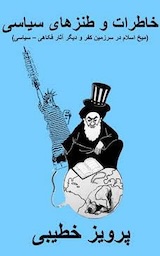Cartoon by Zemgus Zaharans
Another Putin Critic Apparently Poisoned
Editorial
The New York Times: Aleksei Navalny — reportedly still in a coma — has finally been allowed to fly to Germany for treatment, so at least the mystery of what caused Russia’s most prominent opposition figure to collapse in terrible agony on a flight over Siberia may be resolved. But if it does turn out to be poison, to which all signs point, it will still not explain who attacked him or why.
That may never be known. Just as it remains unknown who was behind the killings of the politician Boris Nemtsov, the journalists Anna Politkovskaya, Vladislav Listyev and Yuri Shchekochikhin, the human-rights activist Natalia Estemirova or the American journalist Paul Klebnikov, to name a few.
Poisons of various kinds have been deployed in political hits — a fatal dose of polonium 210 against Alexander Litvinenko and a drug called Novichok against Sergei Skripal, both former Russian intelligence officers attacked in England; dioxin against the former Ukrainian President Viktor Yushchenko; unknown toxins against Vladimir Kara Murza, a Russian journalist who lobbied in the West for sanctions against Kremlin operatives; and Pyotr Verzilov, unofficial spokesman for the band Pussy Riot.
In none of these cases have the person or persons who ordered the attack been identified, even when hit men have been arrested and put on trial. But when so many prominent Russian gadflies fall prey to unexplained and often fatal attacks, there isn’t much benefit of the doubt left to give.
Almost immediately after Mr. Navalny was taken ill, the almost universal presumption on Russian social media and in Western news reports was that Russia’s best known opposition figure — really its only active opposition figure — was the target of a premeditated attack. A hit on so prominent a figure, with the inevitable eruption of global and domestic fury, would presumably require sanction from the highest echelons of power.
Until now, despite Mr. Navalny’s years of tireless and very public activism and innumerable arrests and attacks, the Kremlin has stopped short of putting him away for good, usually limiting his stints in detention to a month or less. The most brutal action against him was a toxic dye thrown into his face by Kremlin loyalists three years ago, for which he was treated in Europe. By contrast, Mikhail Khodorkovsky, once Russia’s richest man, was imprisoned for a decade and driven into exile; two members of Pussy Riot spent 21 months in prison.
The widespread presumption had been that President Vladimir Putin is prepared to tolerate an opponent for appearances sake, a kind of permanent and predictable opposition to a permanent ruler. So far, Mr. Putin’s spokesman has expressed only detached concern about Mr. Navalny, wishing him a “speedy recovery” and insisting that it was up to the doctors in Omsk to determine whether he could be flown for treatment abroad. That is pathetically transparent: Russian social media has been full of plainclothes officers swarming through Hospital No. 1 in Omsk, and the Germans who flew in on an evacuation flight were kept away from the public. Mr. Putin’s supporters have been suggesting that Mr. Navalny was dead drunk, or floating the oft-used canard that he was attacked by someone interested in creating a crisis for Mr. Putin.
But Mr. Navalny’s exposés of corruption among the “crooks and robbers” at the top, including a blistering YouTube documentary on the lavish properties, yachts and Tuscan vineyards owned by former prime minister and former president Dmitri Medvedev, earned him powerful enemies. Of late, he had been actively cheering on the ongoing protests in the city of Khabarovsk, and the anti-government demonstrations in Belarus — rebellions that surely triggered Mr. Putin’s fear of a Ukraine-like popular uprising in Russia.
Was Mr. Navalny’s support of those efforts enough to provoke a murderous attack and risk the global opprobrium? Mr. Putin has certainly shown no qualms about striking at foes at home and abroad. But it is equally possible that some other shadowy figure in the Russian kleptocracy decided to silence him. Ramzan Kadyrov, the strongman of the Chechen Republic within Russia, for one, is believed to be responsible for several assassinations, most likely without approval from the Kremlin.
What is certain is that Mr. Putin, through his disdain for human rights and the rule of law, has set the tone for his nation, and has made it dangerous for anyone who dares rise up against corruption, lawlessness or injustice. Given the murky politics of the Kremlin, it may indeed be that Mr. Putin and his lieutenants did not order the hit on Mr. Navalny, who stands to become a bigger problem as a martyr than he was as a gadfly. But, as the Russian expression goes, “You cooked the kasha, you eat it.”
It is too early to know whether Mr. Navalny will survive or recover, and if so what permanent damage he may have suffered. Flying him to a clinic in Berlin gives him his best chance, and the sooner he reaches it the better. It is also the best chance for determining whether Mr. Navalny was poisoned, and with what. That, in turn, would make it possible to determine by whom, and to do something about it. Under the Global Magnitsky Act, named for a Russian accountant who died in detention after exposing large-scale theft by Russian officials, the United States president can impose visa bans and targeted sanctions on anyone responsible for human rights violations or massive corruption.
Russia has seen many instances of justice deferred. Let us hope that the investigation into Mr. Navalny’s case is quick and thorough, and that the president of the United States has the fortitude to punish those responsible.










He took Putin's Covid vaccine. It is more potent than Trump's Clorox vaccine!